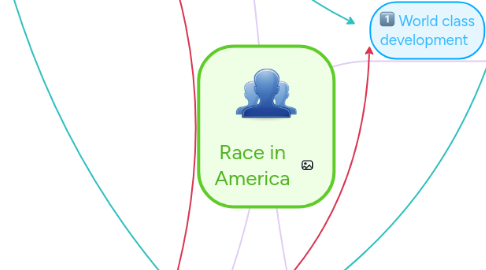
1. Outside influence
1.1. changing immigration policy
1.1.1. "Creole resentment focused on Afro-Caribbean and Chinese immigration. Beginning in 1900, sugar planters lobbied for a new immigration law"
1.1.1.1. allowed cheap seasonal labor for harvest
1.1.2. Brazil as it is was trying to balance off African blood without having to worry about importing Asian blood too.
1.2. Elites affected by European ideas regarding race
1.2.1. "Between 1880-1930, Hispanic American Intellectuals were strongly influenced by positivism, social Darwinism, geographical determinism, and many racial theories emanating from Europe"
1.2.2. Elites identified more closely with Europeans than with their own countrymen.
1.2.3. Brazilian intellectuals picked up racist ideas from abroad
1.3. New Source of Racism
1.3.1. Nazi Movement
1.3.1.1. Brazilian authorities worried that the propaganda directed at German-speaking and Italian-speaking minorities would influence political racism by Mussolini and Hitler's regimes.
1.3.2. in the late 1880's, blacks and Indians became insignificant minorities and immigration became a major social issue
2. racial theories
2.1. miscegenation
2.1.1. Consequences of cross-breeding: the possible emerge of a new Latin American race
2.1.2. Emergence of mestizos and mulattoes in politics represented a threat to elite power.
2.1.2.1. the "Indian Problem"
2.1.2.1.1. "19th century Argentineans waged war against native people. Natives who inhabited the Argentinean plains called the pampas were eliminated by colonists who sought the fertile soils and wild cattle and horses"
2.1.2.1.2. "Given Argentina’s anti-native policies, the new immigrants from Europe made Argentina one of the “most European republics” in south America"
2.1.2.2. the "Black Question"
2.1.3. Brazilians thinkers worried that heavy miscegenation had predestined them to perpetual third class status as a nation
2.2. Racism/discrimination
2.2.1. the darker races were bound to be dominated and perhaps eliminated, by the "stronger" white race.
2.2.2. black inferiority and white superiority believed in Brazil
2.2.3. theory of racial superiority
2.2.4. Xenophobia in Argentina
2.3. liberal ideology
2.3.1. 1. "virtually no one believed in the simple theory of biological inferiority..."
2.3.2. 2. "Abolitionist did worry about the large, illiterate, unskilled mass represented by the slaves."
2.3.3. 3. "Abolitionist believed that miscegenation would gradually and inexorably "whiten" and thereby "upgrade" the Brazilian population."
2.4. thoughts on race
2.4.1. the history of Brazilian thought about race changed after total abolition was enforced in 1888.
2.4.2. rejection of racism
2.4.2.1. Brazilians found it difficult to defend anti-racist doctrines against the pressure of prestigious opinion abroad.
2.4.2.2. Brazilian revolt against racist thought was directed related to the discrediting of racist theories among European and North American scientist.
2.4.3. there was no inherent reason why the inferior races could not catch up
2.4.4. biogenetical correlation
2.4.4.1. colored races were inferior and not adaptable to white society
3. World class development
3.1. whitening ideology
3.1.1. whitening through European immigration in order to achieve economic development and civilization.
3.1.1.1. The Argentinean state used these immigrants and presented itself as a nation of whites and not a country of mixed race people
3.1.2. Argentina's Glorification of "whitening" :
3.1.2.1. Anglo-Saxon and Christian united states was the incarnation of civilized race.
3.1.2.2. vision of race and faith
3.1.3. elites and abolitionists hoped to maximize the influence of more advanced civilization, "the whiter, the better".
3.1.4. Brazil: accepted the mulatto but not the black
3.1.5. Brazilian compromise
3.2. modernization
3.2.1. At the end of the 19th century most of Hispanic America experienced a period of economic growth.
3.3. independence/War
3.3.1. Cuba only gained its independence from Spain thanks to the participation of Afro-Cubans on the side of Creoles.
3.3.1.1. Blacks and mulattoes took an active part in Cuba's economy and society and played a fundamental role in forging Cuban identity.
3.3.2. "Blacks formed a disproportionate part of the argentine army in the long and bloody war of Paraguay (1865-1870). Many Afro-Argentineans died in this war.."
3.3.3. Little war of 1912
3.3.3.1. struggle for the races about cross-breeding.
3.3.3.2. encouraged white immigration while prohibiting the immigration of blacks
4. elite power
4.1. The elites from major cities were the ones to benefit from modernization.
4.1.1. For a part of the population, this meant an increase in cost of living, loss of land, and exploitation.
4.1.2. "Members of the Brazilian intellectual and political elite were consciously catering to European prejudices in order to win the capital and immigrants they believed indispensable for Brazil's development."
4.2. In many countries the elite was Creole (white of Spanish origin born in Hispanic America)
4.2.1. Afro-Cuban intellectuals were not sufficiently strong enough to get the recognition of the Creole elites.
4.3. the elites visited Europe and the U.S. in search of models while ignoring their own countries.
4.3.1. the elite had taken racist ideas from Europe and North America.
